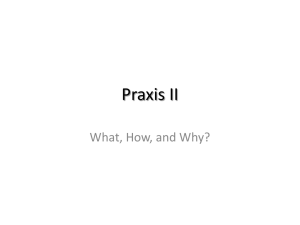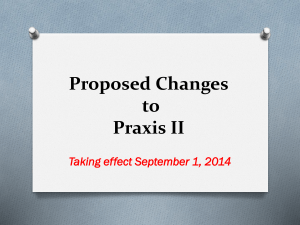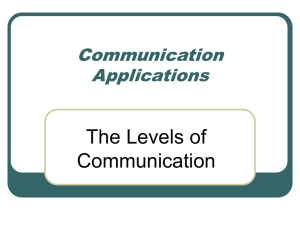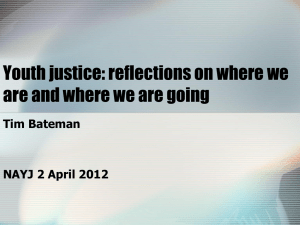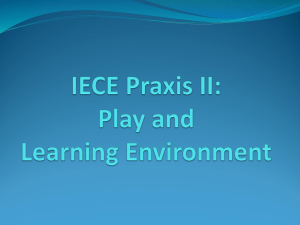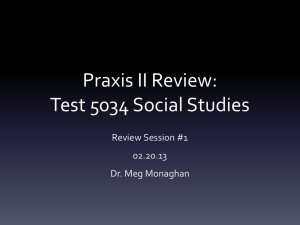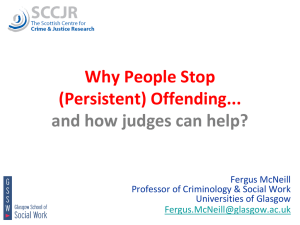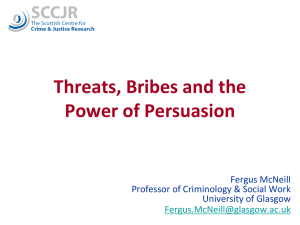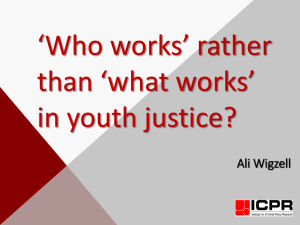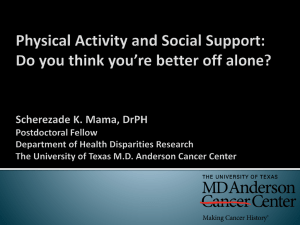Hearing new voices: Re-viewing Youth Justice Policy through
advertisement
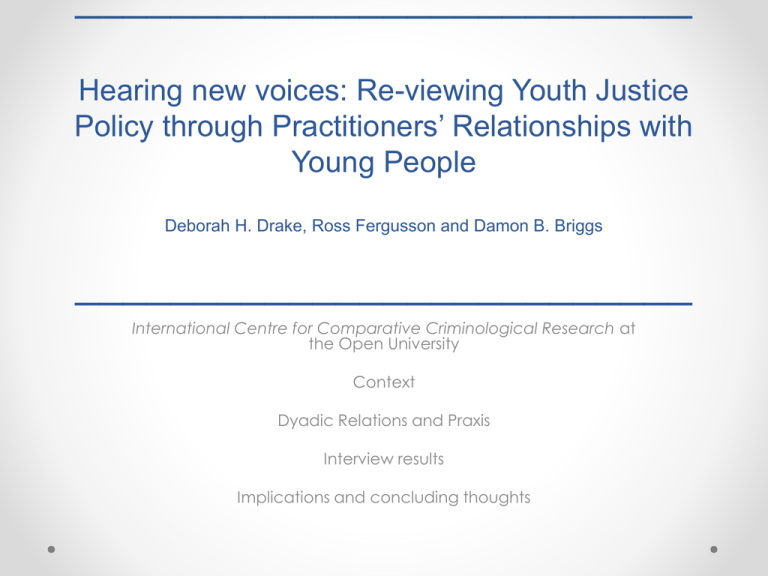
__________________________ Hearing new voices: Re-viewing Youth Justice Policy through Practitioners’ Relationships with Young People Deborah H. Drake, Ross Fergusson and Damon B. Briggs __________________________ International Centre for Comparative Criminological Research at the Open University Context Dyadic Relations and Praxis Interview results Implications and concluding thoughts The ‘New Youth Justice’ and practitioner-young person relations • Managerialism National standards, Standardisation, decreased discretion, technocratic and formulaic (Fergusson, 2007; Case, 2006; McLaughlin and Muncie, 2000) • ‘What works’ agenda • ‘Authoritarian corporate correctionalism’ (McNeil, 2006: 128): ‘Zombification of youth justice’ (Pitts, 2001) ‘… the overwhelming desire of government to control policy all the way down to the point of implementation means that a rich repertoire of responses to the complex problem of youth crime is reduced to a narrow range of correctional techniques....’ (Pitts’ (2001: 12). Discretion, ‘practice wisdom’ and relationships • ‘Street Level Bureaucracies’ (Lipsky, 1980) • ‘Practice wisdom’ (DeRoos, 1990: 282) form of professionally or locally held knowledge that practitioners draw upon when exercising discretion. • Resistance is everywhere ‘Compliance drift’ under Asset (Baker, 2005) Autonomous practitioners (Briggs, 2013) ‘Discriminatory potential’ (Eadie and Canton, 2002) • Coalition Government – increased discretion? What actually ‘works’? Relationships matter • Practitioner – young person relationship essential to desistance: inter-personal skills, discretion, warmth, trust, empathy, advocacy (Phoenix and Kelly, 2013; Sharpe, 2011; Annison et al., 2008; McNeill and Maruna, 2008; Barry, 2007; Farrow et al., 2007; Stephenson et al., 2007 McNeill, 2006a, 2006b; Barron, 2000) • France and Homel (2006: 305−306): ‘is not so much programmes and content but a good supportive relationship with an adult who is not judgmental and is able to offer guidance and advocacy when needed’. • Prior and Mason (2010: 211) “question of how to secure young people’s engagement is scarcely examined in research on interventions with young offenders, despite an apparent preoccupation with ‘what works’”. Dyadic Relationships and use of Praxis • Dyadic relationships involve two people in a relationship that includes some level of interdependency. Unity through conflict (Sears, 1951; Simmel, 1902) Reciprocal incremental disclosure (Wolman, 1973). • Praxis Theory and knowledge in practice/ action ‘Praxis refers to the link between theory and practice, and the struggle that exists in all intellectual movements to transform existing (oppressive or marginalizing) societal conditions into meaningful reflection, action and change. Praxis is a complicated and intricate phenomenon because it entails a reconstitution of culture, institutions, relationships and social interaction, such that a more humane, emancipatory climate of pro-social civic life prevails’ (Arrigo, 2001: 219−220). • Obstacles to praxis: Do current policies permit self-determination? Acting on ‘true words’ will not always produce change Issues with replicability ? Practitioner – young person relationship pilot study results • Semi-structured in-depth interviews with a range of YOT practitioners. • Limited sample but supplemented and backed up with other research literature. • Perspectives of practitioners offer crucial reference points for interpreting young people’s accounts of moving away from offending and relationships with workers. Evidence for the importance of the practitioner – young person relationship “… well I think the relationship with the officer will then affect the level of engagement and that’s just a magic formula isn’t it? Why do some people get on and some don’t?” “Well also I think it’s about if the young person has someone to listen to them, which doesn’t have to be done in a namby pamby [sic] way, you can be quite firm or strict with somebody if you like but they have got respect for that…. I think it is a mutual respect which makes a big difference”. “And also just having somebody that is not directly related to the family who may be in a position of authority, who can relate to them, act as an advocate for them, which I think we do and be firm and fair and consistent”. Trust, mutual respect, genuineness, warmth, empathy and advocacy - essential elements of helping relationships with children (Green et al., 2013; Milbourne, 2009b; Merton et al., 2004; Brandon et al., 1998) Evidence of Simmel’s dyadic relations of conflict and inter-dependency “I have had some very difficult conversation with some of them…. I’ve said look you know your behaviour has been very difficult, I am going to have to take you back to court and you will have to go to custody but we can work through that and still have the relationship because they have known all along that that will happen to them if they do that”. Ilan (2010: 32) study – “I’ll need to stay with them for a year nearly before finally I could say to them…. They have to be aware they might be the kings of the block, but they’re not the kings of the world as such and they can’t do anything they want to do… a year anyway for any impact to be had… or understanding to be instilled”. ‘initiate a gradual process of transformative reflexivity’ “… interestingly there are situations where some young people have ended their orders and they are actually quite disappointed because they have lost… the support network they have had here. There have been reported cases of reoffending which well may be linked to that, the need to get back that support again”. Respecting young people’s autonomy “So I look at current use, what they are using but I focus on strengths and their attitude to drugs, how they view the future. And whether or not there is anything we can work on. If they say I’m not looking to make any change, then in a nutshell I can’t impose that. Then I say it would be great if I could but I can’t. So let’s look at what we can do…. It’s a difficult area of work to impose on a young person because they have their own views, so right from the off I say I can’t make you do anything, but I will help you live more healthily in a way that will stop you coming back in contact with the court.… You need to respect their control”. “. If you can find their one little hook…With a girl that was here on an intensive order she went to work at the manor in the stables and that was her little bit of a saviour. She didn’t like horses, she didn’t want to ride but she loved being there and doing all the mucking out… so it is just trying to find that thing for them.” Dyadic relations, space and place “The work that we did with him, we gradually re-engaged him. He was a very bright boy, but what we did to begin with, so things like, for example we would go to the city centre for a walk and he would have to go and get something from the shop. And he was amazed that his officer would talk to other people in a shop, you know how you do… he would say why are you talking to that person you don’t know them? ... and it kind of brought out the issue of communication and introducing him to new things?” • Rodd and Stewart’s (2009: 8) study: The informal stuff is as important as the formal stuff; it is the glue that holds our work together, the unstructured time, the coffee breaks, the sitting around the campfire…. It can work to ‘walk and talk’ Broadening horizons “He began to realize that he hadn’t wasted everything because he was quite bright but he hadn’t been at school. So he got into college….there is still the odd blip if you like….he also found a girlfriend which was also a stabilizing influence…. We did interesting interventions with him… he would say I haven’t been to this part of [place] before. So we would do a lot about broadening his horizons, making him do things that were slightly out of his comfort zone. Probably it was quite successful with him.” • Lemma (2010: 18−19) study – reimagining their own capabilities. • Respectful relations encourage change • Tipping points and moments that matter “He began to realize that he hadn’t wasted everything” “If you can find their one little hook” Annison et al. (2008: 266) – ‘Ah ha’ moments Lemma (2008) “you have to give them space... its like a switch” Concluding comments • Critical question: What would the young people have made of the quality of the relationship? • Dyadic relationships, dynamism and discretion key. • Little research on minutiae of successful working relationships identifying ‘moments that matter’. • Need for increased focus on practitioner and young people’s voices. • Challenges ahead? References • • • • • • • • • • • • • • • • • • • • • • • • • • • • • Annison J, Eadie T and Knight C (2008) People first: Probation Officer perspectives on probation work. Probation Journal 55(3): 259–271. Arrigo B (2001) Praxis. In: McLaughlin E and Muncie J (eds) The Sage Dictionary of Criminology. London: Sage Baker K (2005) Assessment in Youth Justice: Professional Discretion and the Use of Asset. Youth Justice 5 (2): 106−122. Barron, C.L. (2000) Giving Youth a Voice: A Basis for Rethinking Adolescent Violence. Halifax, Canada: Fernwood Publishing. Barry M (2007) Listening and learning: the reciprocal relationship between worker and client. Probation Journal 54(4): 407–422. Brandon M, Schofield G and Trinder L (1998) Social Work with Children. London: Palgrave Macmillan. Briggs, D. B. (2013) Conceptualising Risk and Need: The Rise of Actuarialism and the Death of Welfare? Practitioner Assessment and Intervention in the Youth Offending Service. Youth Justice, 13,1, 17-30. Case S (2006) Young people ‘at risk’ of what? Challenging risk-focused early intervention as crime prevention. Youth Justice 6(3): 171–179. DeRoos YS (1990) The development of practice wisdom through human problem-solving processes, The Social Service Review, 64, 2: 276-287Dowden C and Andrews DA (2004) The importance of staff practice in delivering effective correctional treatment: A meta-analytic review of core correctional practice. International Journal of Offender Therapy and Comparative Criminology 48(2): 203–214. Farrow K, Kelly G and Wilkinson B (2007) Offenders in Focus. Bristol: Policy Press. France A and Homel R (2006) Societal access routes and developmental pathways: Putting social structure and young people’s voice into the analysis of pathways into and out of crime. Australian & New Zealand Journal of Criminology 39(3): 295–309. Ilan J (2010) If you don’t let us in, we’ll get arrested’: Class-cultural dynamics in the provision of, and resistance to, youth justice work. Youth Justice 10(1): 25– 39. Lipsky M (1980) Street-level Bureaucracy. New York: Russell Sage Foundation. McLaughlin E and Muncie J (2000) The criminal justice system: New Labour’s new partnerships. In: Clarke J, Gewirtz S and McLaughlin E (eds) New Managerialism, New Welfare? London: Sage/Open University. Ilan J (2010) If you don’t let us in, we’ll get arrested’: Class-cultural dynamics in the provision of, and resistance to, youth justice work. Youth Justice 10(1): 25– 39. McNeill F (2006a) Community supervision: Context and relationships matter. In: Goldson B and Muncie J (eds) (2006) Youth Crime and Justice: Critical Issues. London: Sage Publications. McNeill F (2006b) A desistance paradigm for offender management. Criminology and Criminal Justice 6(1): 39–62. McNeill F and Maruna S (2008) Giving up and giving back: Desistance, generativity and social work with offenders. Research Highlights in Social Work 48: 224–339. Merton, B. et al. (2004) An Evaluation of the Impact of Youth Work in England, Nottingham, Department for Education and Science Milbourne L (2009a) Youth matters: Are recent policies generating new spaces for young people’s voice and participation? Research Intelligence 109 (winter issue): 22–23. Pitts J (2001) Korrectional karaoke: New Labour and the zombification of youth justice. Youth Justice 1(2): 3–16. Prior D and Mason P (2010) A different kind of evidence? Looking for ‘What Works’ in engaging young offenders. Youth Justice 10(3): 211–226. Prior D and Mason P (2010) A different kind of evidence? Looking for ‘What Works’ in engaging young offenders. Youth Justice 10(3): 211–226. Publications. Sears R (1951) A theoretical framework for personality and social behavior. American Psychologist 6(9): 476–482. Sharpe G. (2011) Beyond Youth Justice: Working with Girls and Young Women who Offend. In Sheehan, R., McIvor, G., and Trotter, C. (eds) Working with Women Offenders in the Community. Abingdon: Willan Publishing. Simmel G (1973) On individuality and social forms. In: Wolman BB (1973) Dictionary of Behavioral Science. New York: Ven Nostrand Reinhold. Stephenson M, Giller H and Brown S (2007) Effective Practice in Youth Justice. Cullompton: Willan Publishing. Wolman BB (1973) Dictionary of Behavioral Science. New York: Van Nostrand Reinhold.
